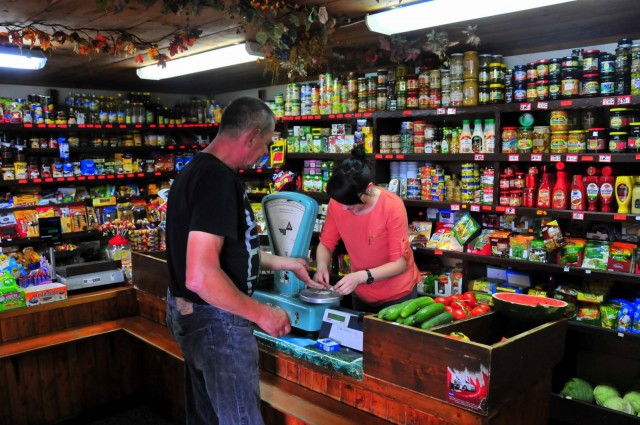I needed a store description. I recalled a picture I took this summer in Lipnica. And off I went, leaving blanks where words failed.

The only thing about Pani Janowiak’s shop that ever changed was the produce in the bins just to the sides of the cash register. Winter months saw only potatoes, leeks, onions, the occasional beet or cabbage, perhaps an apple or two. Summer months the bins overflowed with cucumbers, plums, radishes, pears, tomatoes, grapes, zucchini, apricots, fresh dill, strawberries, lettuce, cherries, cabbage, raspberries, even the occasional bunches of bananas or small watermelons. Other than produce, though, nothing else changed. The jars of jams and preserves on the top shelf just behind the cash register were forever in the same order, new orders simply filling the empty slots when this or that jam sold out. Below the jams were all assortments of preserved meats and fish, the squat cans of tuna stacked between jars of pickled herring, and long tins of anchovies and ________. the The piquant Polish ketchup jars and ____ stood in attention just behind Pani Janowiak’s left shoulder, four brands in five columns, the most popular brand having two columns to keep up with demand, and by them, the mustard. Just above them were the pickled vegetables and mushrooms, jars of varying sizes and shapes glowing different colors as the ever changing light shifted through the day. Over Pani Janowiak’s right shoulder was one of the pillars of Polish hospitality: myriad teas–some herbal, others black, some medicinal, others merely recreational–and coffees, some in expensive vacuum-sealed packages imported from Germany, others in loose-filled bags. Below all these shelves, on the small counter that ran the length of all the wall-hung shelves, were spices and preparations, mixes to make soups and sauces, powders to add to gravies and the like. The shelves on the left of the store, the shelves through which Pani Basia glanced every day countless time as she looked through the small window the shelves framed to see how long the shadows and grown and judge how much longer she needed to stay open, whether she could close shop early, these shelves held the other pillar of Polish hospitality: cookies and chocolates. This was also where baking goods lived, the various flours, leavening agents, and sugars. Just to the left of these sweets stood a small refrigerator with milk and cream. The right side of the shop held a refrigerated display case with hams and sausages, various meats for sandwiches and snacking. Just behind it was a chest freezer with chicken quarters, ground beef, and a few other rotating frozen products. Beside the freezer was another tall shelf for drinks: juices and sodas (national and imported). Squeezed among the empty spaces on the counter were small displays for chewing gum and a small tree-like structure for suckers. Baked goods were tucked into a small space of empty shelving in a corner of the shop, or stacked wherever room could be found.
The shop was always faultlessly clean but still had a certain tired look to it. The linoleum was curling up where it met the counter, and the shelves were painted a dull brown color that made them look dirty even when they were clean. The scale was a tired gray, the vegetable bins, painted the same brown as the shelves behind Pani Janowiak, were more worn from the constant contact of customers whereas the shelves’ paint retained a relatively new appearance as Pani Janowiak was the only one to handle products on that side of the counter.
On the day that Pani Basia died, as she was waiting in line for her Danish and juice, she glanced around Pani Janowiak’s shop and noticed all these details for the millionth time it seemed. She looked at the ketchup bottles and thought what a nice touch it would be for Pani Janowiak to arrange them in some way that made sense, either according to the size of their containers or perhaps, more subtly, in alphabetical order according to their brands. She looked at the drinks, always a little dismayed that they were arranged so hodge-podge, with little regard to type of juice or origin of soda. Shouldn’t all the Polish brands be together, with Coke and Pepsi, the newly introduced interlopers, segregated? She wondered about the wisdom of having the flour so close to the floor, for it seemed possibly–likely even–to have unsanitary consequences. After all, how easily would it be for a splash of muddy water from the daily mopping to land on the paper packing, blanch through, and contaminate the contents? She wished the cabbages had been better stacked, with all the smaller ones to one side of the bin to make it easier for customers to find precisely what they were looking for. One doesn’t always need the biggest head after all, right?
Does this sound familiar???? “Good job!”